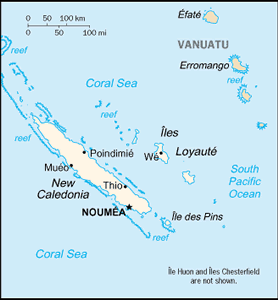The Geography of New Caledonia
The Geography of New Caledonia
New Caledonian Geography
Location: Oceania, islands in the South Pacific Ocean, east of Australia
Geographic coordinates: 21 30 S, 165 30 E
Map references: Oceania
Area: total: 19,060 sq km land: 18,575 sq km water: 485 sq km
Area - comparative: slightly smaller than New Jersey
Land boundaries: 0 km
Coastline: 2,254 km
Maritime claims: territorial sea: 12 nm exclusive economic zone: 200 nm
Climate: tropical; modified by southeast trade winds; hot, humid
Terrain: coastal plains with interior mountains
Elevation extremes: lowest point: Pacific Ocean 0 m highest point: Mont Panie 1,628 m
Natural resources: nickel, chrome, iron, cobalt, manganese, silver, gold, lead, copper
Land use: arable land: 0.32% permanent crops: 0.22% other: 99.46% (2005)
Irrigated land: 100 sq km (2003)
Natural hazards: cyclones, most frequent from November to March
Environment - current issues: erosion caused by mining exploitation and forest fires
Environment - international agreements:
Geography - note: consists of the main island of New Caledonia (one of the largest in the Pacific Ocean), the archipelago of Iles Loyaute, and numerous small, sparsely populated islands and atolls


